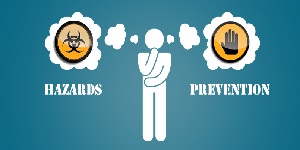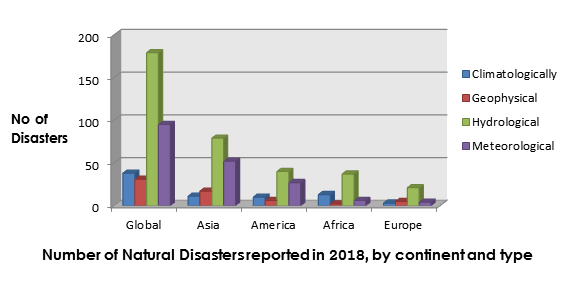
Hazard 2019

Theme: It Can Never be Eliminated but Can be Reduced
The Meetings International invites you to attend the World Hazards Congress amid November 27-28, 2019 in Dubai, UAE, with the theme "It cannot be eliminated but can be reduced". Hazard 2019 has been outlined in an interdisciplinary way with foster discussion by maximizing interactions, collaborations and networking opportunities for invited speakers, researchers and scientists mainly emphasis on large-scale research approaches and technologies in the sessional tracks to provides with a unique opportunity to get together at our 2-days scientific program. Hazard 2019 is a global platform to discuss and learn about factors, causes and consequences of natural hazards, disaster risk reduction strategies and its associated fields related to geoscience, coastal geography, geographic information & remote sensing, alarming alerts and early warning systems, floodway analysis, disaster risk management. At present, the current scenario of the hazards is at alarming levels in the fields of natural hazards, disaster management and environmental sciences. The present studies and research trend is of particular significance because most of it is the very likely natural occurrence, human-induced and proceeding at a rate that is unprecedented rates. Research on disaster and its reduction management policies, other technological advances have enabled scientists to collect different types of information about its origin, causes, vulnerability, resilience, public awareness on a global scale.
Why to attend?
People from around the world are looking forward to build an eco-friendly and environmentally sustainable building, designed, constructed and operated to minimise the total environmental impacts. It provides a premier technical forum for reporting and learning about the latest research and development, as well as for launching new applications and technologies and the effectiveness of various regulatory programs towards hazards. World-renowned speakers, scientists, researchers with the most recent techniques, developments, and the newest updates in hazards are hallmarks of this conference. So we take an initiation to gather researchers from around the world at a single stage to discuss the environmental concerns, causes, parameters, risk assessment, vulnerability, resilience, public awareness and strategy to reduce the loss affected by hazards for the environmental sustainability . We assure World Hazards Congress is going to build a new enthusiasm among the people on importance of hazardous risk management strategies.
Target Audience:
- Geo-technical specialists
- Earthquake engineers/ Seismist
- Volcanologist
- Urban planners, hydro geologists
- Landslide geologists and engineers
- Climatology experts
- Emergency disaster volunteers
- Construction management and building resilience researchers
- Emergency disaster and safety officers
- Environmental and natural science researchers, faculty and students
- Environmental hazards and disaster prevention associations, societies and government agencies
- Business experts/ suppliers/ research development teams in natural hazards and disaster management.
Join us for a symphony of outstanding technology and enjoy the spectacular and uniqueness of Dubai, UAE.
1. Natural Hazards and Disaster Management
A natural hazard is a natural phenomenon that might have a negative impact on the environment or humans. The natural hazard can be classified into two broad categories:
- Geophysical
- Biological
Geophysical hazards encompass geological and meteorological phenomena such as earthquakes, volcanic eruptions, wildfires, cyclonic storms, floods, droughts, avalanches and landslides. Biological hazards can refer to a various array of disease, infection, infestation and invasive species.
A natural disaster is a major adverse happening resulting from natural processes of the earth; examples are floods, hurricanes, tornadoes, volcanic eruptions, earthquakes, tsunamis, and other geological processes. A natural disaster can cause loss of life or property damage and leaves economic damage in its wake, the severity of which depends on the affected population's resilience or ability to recover and also on the infrastructure available
2. Ergonomic Hazards/ Occupational Health Hazards
Ergonomic hazards or Occupational health hazards are defined as a condition that results from exposure in a workplace to a physical, chemical or biological agent to the extent that the normal physiological mechanisms are affected and the health of the worker is impaired or may be defined as the type of work, body position and working conditions create a strain on your body. They are unbreakable to spot since you don't always immediately notice the strain on your body or the harm these hazards pose. Short-term exposure may ends in "sore muscles" the next day or in the days following exposure, but long-term exposure can deal in serious long-term injuries.
Ergonomic hazards include:
- Poor lighting
- Improperly adjusted workstations and chairs
- Frequent lifting
- Poor posture
- Awkward movements, especially if they are repetitive
- Repeating the same movements over and over
- Having to use too much force, especially if you have to do it frequently
3. Physical Hazards, Biological Hazards & Chemical Hazards
Physical hazards are the most predictable and will be present in most workplaces at one time or another. They include vulnerable conditions that can cause injury, illness and death.
Examples of physical hazards include:
- Electrical hazards: frayed cords, missing ground pins, unacceptable wiring
- Unguarded machinery and moving machinery stuff: guards removed or moving parts that a worker can accidentally touch
- Constant loud noise
- High vulnerability to sunlight/ultraviolet rays, heat or cold
- Working from heights, exposure ladders, scaffolds, roofs, or any raised work area
- Working with mobile apparatus such as forklifts
- Spills on floors or tripping hazards, such as for occluding aisle or cords running across the floor
A Biological hazards comes from working with animals, people or infectious plant stuff. Work in day care, hospitals, hotel laundry and room cleaning, laboratories, veterinary offices and nursing homes may uncover you to biological hazards.
Certain things you may be unveiled to include:
- Blood or other body fluids
- Fungi
- Bacteria and viruses
- Plants
- Insect bites
- Animal and bird droppings
Chemical hazards occurs when a worker is exposed to any chemical preparation at the workplace in any form (solid, liquid or gas). Some are safer than others, but to some workers who are more sensitive to chemicals, even common one's can cause illness, skin irritation or breathing problems.
An indivisual should beware of:
- Liquids like cleaning products, paints, acids, solvents especially chemicals in an unlabelled container (warning sign!)
- Vapours and fumes, for instance, those that come from welding or exposure to solvents
- Gases like acetylene, propane, carbon monoxide and helium
- Flammable materials like gasoline, solvents and explosive chemicals
4. Hydrometeorological Hazards
Hydrometeorological hazard is an phenomenon of atmospheric, hydrological or oceanographic nature that may cause loss of life, injury or other health impacts, property damage, loss of livelihoods and services, social and economic disruption, or environmental damage (includes tropical cyclones, thunderstorms, hailstorms, tornados, blizzards, heavy snowfall, avalanches, coastal storm surges, floods including flash floods, drought, heat waves and cold spells). They account for a dominant fraction of natural hazards which occur in every portions of the world, although the frequency, intensity, and vulnerability of certain hazards in some regions differ from those in others.
5. Anthropogenic Hazards, Technological Hazards & Sociological Hazards
Anthropogenic hazards are due to human behaviour and activity. The social, natural and built environment is not only at risk of geophysical hazards but also from technological hazards including industrial explosions, the release of chemical hazards and major accident hazards (MAHs). Sociological hazards include crime, terrorist threats and war.
6. Climate-Resilient and Adaptive Infrastructure Systems
Climate-resilient & adaptive infrastructure design and risk management, MOP 140, provides guidance for and contributes to the developing or enhancing of methods for infrastructure analysis and design in a world in which risk profiles are changing and can be projected with varying degrees of uncertainty requiring a new design philosophy to meet this challenge. Adaptive design, provides guidance for and contributes to the developing or enhancing of methods for infrastructure analysis and design in a world in which risk profiles are changing and can be projected with varying degrees of uncertainty requiring a new design philosophy to meet this challenge.
7. Risk Analysis, Assessment, Management & HAZOP
Risk analysis, assessment & management was defined as a continuous management process with the objective of revealing, analysing, and assessing potential hazardous events in a system, and identifying and initiating efficient risk control measures to eliminate or reduce possible harm to people, the environment, or other assets. Risk management is an integrated part of all good management.
The objectives of risk analysis are to:
- Identify hazards and threats related to the case object.
- Identify potential hazardous happening that may occur related to the study object.
- Find the causes of each hazardous event.
- Identify barriers and safeguards that can prevent or reduce the probability of hazardous events or the consequences of these events, and assess the reliability of these barriers.
- Identify accident
A hazard and operability study (HAZOP) is a structured and systematic examination of a complex planned or existing process or operation in order to identify and evaluate problems that may represent risks to personnel or equipment.
8. Early Warning & Vulnerability Assessment
Early warning is a critical element of disaster risk reduction. It can prevent loss of life and reduce the economic and material influence of hazardous events including disasters. To be effective, early warning systems need to actively include the people and communities at risk from a range of hazards, facilitate public education and awareness of risks, disseminate messages & warnings efficiently and ensure that there is a constant state of preparedness and that early action is enabled. A vulnerability assessment is an act of identifying, quantifying, and prioritizing the vulnerabilities in a system. Examples of vulnerability assessments are performed include but are not limited to, information technology systems, energy supply systems, water supply systems, transportation systems, and communication systems. Those assessments may be conducted on behalf of a range of different organizations, from small businesses up to large regional infrastructures. Vulnerability from the interpretation of disaster management means assessing the threats from potential hazards to the population and to infrastructure. It may be managed in the political, social, economic or environmental fields. Vulnerability assessment has many things in quotidian with risk assessment.
Assessments are typically executed according to the following steps:
- Cataloguing assets and ability in a system.
- Assigning quantifiable value and importance significance to those resources
- Identifying the vulnerabilities or potential warning to each resource
- Mitigating or rejecting the most serious vulnerabilities for the most valuable resources
9. Temporal & Spatial Aspects of Risk
Temporal & spatial aspects of risk is based on geospatial analysis, which is taught e.g. in graduate programmes. The term risk adds to the methods of statistical analysis & numerical analysis an unusual focus on geographical aspects of public/environmental health risks or potential damage to infrastructure and services. Spatial aspects are referring to risk part and available resource for risk mitigation. Management of resources according to risk and reallocation of resources may be obligatory according to results of the risk maps. Grass GIS is an open source geographic information system that was originally designed as geographic resource analysis support system and evolved into full-featured GIS in the field of Geomatics.
10. Communication & Economic Risk
Risk communication is the process of notifying people about potential hazards to their person, property, or community. Scholars define risk communication as a science-based approach for communicating effectively in conditions of high stress, high concern or controversy.
Economic risks can be demonstrated in lower incomes or higher expenditures than expected. The causes can be many, for instance, the hike in the price for raw materials, the lapsing of limit for construction of a new operating facility, disruptions in a assembling process, emergence of a serious competitor on the market, the loss of key personnel, the change of a political regime, or natural disasters.
11. Evacuation, Simulation & Design
Evacuation is the immediate egress or escape of people away from an area that contains an imminent danger, an on-going threat or a hazard to lives or property. Simulation is an emulation of the operation of a real-world process or system. The act of simulating something first requires that a model is developed. This model represents the key characteristics, behaviours and functions of the selected physical or abstract system or process. The model represents the system itself, whereas the simulation represents the operation of the system over time. Design risk assessment is the act of determining potential risk in a design process, either in a concept design or a detailed design. It provides a broader evaluation of your design beyond just CTQs and will enable you to eliminate possible failures and reduce the impact of potential failures. This ensures a rigorous, systematic examination in the reliability of the design and allows you to capture system-level risk.
The system of institutions, mechanisms, policy and legal frameworks and other arrangements to guide, coordinate and oversee disaster risk reduction and related areas of policy.
Annually natural disasters continue to strike and increase in magnitude, complexity, frequency and economic impact. At the same time, awareness of the process and potential benefits of disaster reduction is still confined to specialized circles and has not yet been adequately communicated to policymakers and the general public. Natural hazards and disaster management plays an important role to create awareness and providing a platform to share and discuss different types of natural hazards, significance of early warning systems and risk management strategies. The world is looking for reducing exposure to hazards, lessening vulnerability and property wise management, improving preparedness and early warning for adverse events by disaster risk reduction. Calling for development of a "global culture of prevention" and improved risk assessment, broader monitoring and communication of warnings, the conference adopted the natural hazards and disaster management: Guidelines for natural disaster prevention, preparedness and mitigation and we are organizing the series of natural hazards & disaster nanagement conferences.
Annotation: Good governance needs to be transparent, inclusive, collective and efficient to reduce existing disaster risks and avoid creating new ones.
Natural hazards and disasters, whether they occur in advanced or developing nations, can destroy people's livelihoods. Extreme natural and man-made hazards have recently hit both developed and developing countries. While the Asian countries have been successful in achieving economic growth and poverty reduction, the region cannot avoid exposure to a variety of disasters. Indeed, Asia, particularly the area of the ASEAN Member States (AMS), is the most prone region to disasters in the world. Natural Disasters pose negative effects on social structures, environment by disrupting the flows of goods and services, worsening the balance of payments and government budgets, derailing economic growth, income distribution, and poverty reduction. The current scientific sessions notify the mitigate damage arising from disasters, both in terms of the number of human casualties and economic impacts, and preparedness, importance of advance preparations, drawing up emergency plans, disseminating and training emergency knowledge, conducting evacuation drills, constructing early warning systems, and investing in infrastructure and reconstruction efforts, capacity building programs for disaster preparedness, emergency response, relief.
Population growth and rapid urbanization could put 1.3 billion people and more than $150 trillion assets at risk from river and coastal floods by 2020, with Asia as the most exposed region. Natural Hazards Congress 2019 is a timely scientific conference that will address the concerns and issue for environmental sustainability in the ASEAN-5 (Indonesia, Malaysia, Philippines, Singapore and Thailand) countries due to national disasters (economic crisis, health hazards, natural calamity and/or Man-made hazards). Singapore is well-shielded from natural calamities like earthquakes, typhoons and tsunamis. Natural hazards Congress-2019 will provide a forum for discussion of the integration of hazard information into effective emergency risk management. Applying science, technology and research information on best practice planning, warning, response and recovery capabilities will lower the impact of Disasters on the environment. The conference will bring together expertise from international wide to enable the sharing of knowledge and strengthen technical sessions. The subject-specific target audience of the conference is emergency managers, planners, risk assessors, asset and utility managers, natural hazards researchers and scientists, experts on the environmental concerns, delegate participation.
The scope of the meeting is to bring expert geologists, ecologists, professors, geotechnical engineers, geo-scientists, students, researchers, consultants, business experts across the globe and to evaluate the consequences of human-driven disruption of the natural system with a theme of “It can never be eliminated but can be reduced".
Global Universities:
- Laurea University of Applied Sciences, Finland
- Oxford Brookes University, United Kingdom
- Adelphi University, United States
- Eastern Kentucky University, United States
- University College London, United Kingdom
- Vrije Universiteit Brussel, Belgium
- Park University, United States
Graph:

Comparative studies of natural disasters in Asian countries
Asia is the most disaster-prone region in the world. The region has borne brunt of the physical and economic damages of natural disasters. With reference to the data collected by the Centre for Research on the Epidemiology of Disasters (CRED), human toll from natural disasters in the last 5 years has been staggering. The region remains exposed to more natural disasters and according to the Asian Development Bank, the region’s economic progress will be undermined by the rising number of floods, landslides and other disasters. That provides a stark reminder that Asia’s many densely populated and expanding coastal cities will in particular remain vulnerable to weather-related disasters. Floods, earthquakes and cyclones have wreaked havoc across ASEAN countries killing people, wiping out homes, livelihoods and leaving economies in distress. The region occupies 30% of the world's land mass, but 40% of the world's disasters occurred in the region in the past decade, resulting in a disproportionate 80% of the world's disaster deaths. During the last 10 years, according to the Centre for Research on the Epidemiology of Disasters, majority of deaths in Asia were caused by earthquakes, floods have killed 17,442 people while as cyclones were responsible for 13,368 deaths in the region. Asia lost US$15 billion due to natural disasters, according to data released by the Center for Research on the Epidemiology of Disasters (CRED).
Summary
Annually hazards continue to strike and increase in magnitude, complexity, frequency and economic impact. At the same time, awareness of the process and potential benefits of disaster reduction is still confined to specialized circles, and has not yet been adequately communicated to policy makers and the general public. Harards is playing an important role to create awareness and providing a platform to share and discuss on different types of natural hazards, significance of early warning systems and risk management strategies. World is looking for reducing exposure to hazards, lessening vulnerability and property wise management, improving preparedness and early warning for adverse events by disaster risk reduction. Calling for development of a "global culture of prevention" and improved risk assessment, broader monitoring and communication of warnings.
- Natural Hazards and Disaster Management
- Occupational Health Hazards/ Ergonomic Hazards
- Physical, Biological & Chemical Hazards
- Radiation and Nuclear Hazards
- Anthropogenic, Technological & Sociological Hazards
- Climate-Resilient and Adaptive Infrastructure Systems
- Risk Analysis, Assessment, Management & HAZOP
- Early Warning & Vulnerability Assessment
- Evacuation, Simulation & Design
- Disaster Risk Governance
- Journal of Ergonomics Research
- Geoinformatics & Geostatistics
- Expert Opinion on Environmental Biology
- Journal of Forensic Toxicology & Pharmacology
14 Organizing Committee Members
1 Renowned Speakers
Reza HabibiSaravi
Mazandaran University of Medical Sciences
Iran





































































































































